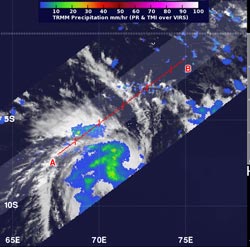NASA Spots First Tropical Cyclone of Southern Indian Ocean Season

When NASA's TRMM satellite passed over Tropical Cyclone 01S on Oct. 12 at 0741 UTC (3:41 a.m. EDT), light to moderate rainfall (blue and green) was occurring over most of the storm at a rate between .78 to 1.57 inches/20 to 40 mm per hour. Credit: NASA/SSAI, Hal Pierce <br>
On Oct. 12 at 1500 UTC (11 a.m. EDT), Tropical Cyclone 01S (TC01S) was “born” about 90 nautical miles (103.6 miles/166.7 km) west-southwest of Diego Garcia, near 8.3 South latitude and 70.6 East longitude. Diego Garcia is a coral atoll located in the south central Indian Ocean and is part of the British Indian Ocean Territory. It is about 1,970 nautical miles (3,650 km) east of Tanzania, Africa.
TC01S had maximum sustained winds near 35 knots (40 mph/64.8 kph), so no sooner formed, than it became a tropical storm. TC01S was moving to the west-southwest at 6 knots (7 mph/11 kph).
When NASA's Tropical Rainfall Measuring Mission (TRMM) satellite passed over TC01S on Oct. 12 at 0741 UTC (3:41 a.m. EDT), the precipitation radar instrument detected light to moderate rainfall occurring over the center and in a band of thunderstorms wrapping into the center from the southwest. That rain was falling at a rate between .78 to 1.57 inches/20 to 40 mm per hour.
Microwave satellite imagery showed that the system is consolidating, and confirmed the band of thunderstorms wrapping into the center from the southern quadrant.
TC01S is in a good environment to continue strengthening. There is low wind shear and warm waters, two factors that allow a tropical cyclone to intensify.
In last year's season, the first tropical cyclone formed on Dec. 5, 2011, about 545 nautical miles west of the Cocos Islands. This year, we're off to an earlier start.
Forecasters at the Joint Typhoon Warning Center expect TC01S to continue intensifying over the next three days, Oct. 12, 13 and 14, before wind shear increases and sea surface temperatures decrease.
Text credit: Rob Gutro/Hal Pierce
NASA's Goddard Space Flight Center, Greenbelt, Md.
Media Contact
All latest news from the category: Earth Sciences
Earth Sciences (also referred to as Geosciences), which deals with basic issues surrounding our planet, plays a vital role in the area of energy and raw materials supply.
Earth Sciences comprises subjects such as geology, geography, geological informatics, paleontology, mineralogy, petrography, crystallography, geophysics, geodesy, glaciology, cartography, photogrammetry, meteorology and seismology, early-warning systems, earthquake research and polar research.
Newest articles

Bringing bio-inspired robots to life
Nebraska researcher Eric Markvicka gets NSF CAREER Award to pursue manufacture of novel materials for soft robotics and stretchable electronics. Engineers are increasingly eager to develop robots that mimic the…

Bella moths use poison to attract mates
Scientists are closer to finding out how. Pyrrolizidine alkaloids are as bitter and toxic as they are hard to pronounce. They’re produced by several different types of plants and are…

AI tool creates ‘synthetic’ images of cells
…for enhanced microscopy analysis. Observing individual cells through microscopes can reveal a range of important cell biological phenomena that frequently play a role in human diseases, but the process of…





















